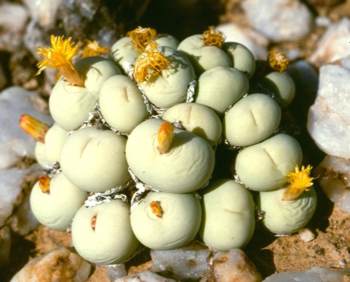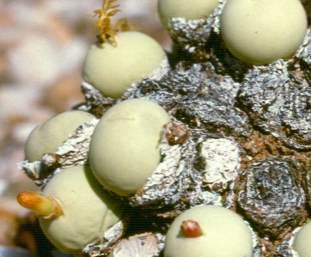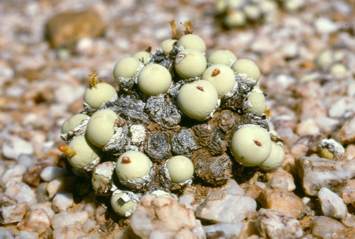Conophytum calculus subsp. calculus
Conophytum calculus (A.Berger) N.E.Br. subsp. calculus
Family: Aizoaceae
Common names: cone plants, dumplings, button plants, sphaeroids, conos; knopies (buttons), toontjies (little toes), waterblasies (water blisters) (Afr.)
SA Tree No: 256
Introduction
These humorous-looking `pebble plants' are easy to grow in pots and their unusual night-time opening flowers have a delightfully spicy scent.

Description
Description
Conophytum calculus subsp . calculus is a small, but very tough, low growing stemless succulent with individual rounded `leaves' (fused together into one body) that multiply with age and cluster together to form a dome-shaped cushion. The spherical leaf bodies are completely smooth and hairless, characteristically opaque (non-transparent and non-glossy) and have a chalky-green to pale yellowish green. The leaf bodies are always without any spots or detail and measure up to 30mm in diameter. New leaves are formed inside the existing ones and when, after a year, the leaf body starts to die, a new one emerges from inside. The old leaf becomes a thin, dry, and smooth, beige sheath, sometimes turning black, which persists on the plant.

As for most Conophytums, this species flowers in autumn. Conophytum calculus subsp . calculus has spicy, clove-scented, golden yellow to dark orange flowers which are nocturnal, i.e. they only open at night. Seed capsules are brown, spotted and very small, 3×5mm, but robust and bear many tiny seeds. The plants can be very long-lived, some individuals have been known to live as long as 40 to 50 years.
Conservation Status
Status
Conophytum calculus subsp . calculus is not threatened.
Distribution and habitat
Distribution description
The Conophytum genus as a whole is endemic to the winter rainfall regions of the Cape provinces of South Africa and the southern part of Namibia. Wherever there is summer rain, in fact, conophytums are absent.

Derivation of name and historical aspects
History
The name Conophytum comes from the Latin word conus, meaning cone (referring to the shape of the leaves of many species) and the Greek word phytum meaning plant. There are approximately 90 different species of Conophytum. The specific name calculus comes from the Latin word for pebble, and describes the hard, rounded and smooth appearance of C. calculus subsp. calculus.
Ecology
Ecology
Conophytum calculus subsp . calculus is found only on the white quartz pebble patches characteristic of the semi-arid regions from where it occurs. White quartz reflects sunlight and therefore creates a much cooler microclimate for the plants compared to the adjacent patches of darker sands and dolerite rocks.
The night-time opening flowers are pollinated by moths, which are guided to the flowers by the strong clove scent. It is not very well known how Conophytum seeds are dispersed, but there are some ideas. Rodents are known to enjoy eating the seed capsules and therefore would act as dispersers for some species. Some species also have capsules with adhering sheaths which may act as parachutes in the wind.
Uses
Use
Along with the genus Lithops, conophytums are the most well-loved and sought after of the dwarf succulents and are important in horticulture.
Growing Conophytum calculus subsp. calculus
Grow
Conophytums love to grow in pots, as they are naturally adapted to growing in cramped spaces. The easiest and most popular method of propagation is by taking cuttings. These should be taken a few millimetres below the growing point, which is where the base of the body joins to the woody stem/sheaths.
A slightly acidic growing medium is best, and can be made up using equal parts of sieved, well-composted potting soil and coarse river sand. Bright morning light and some shade in the afternoon is ideal for the plants. Use warm water in fine sprays to moisten the plants from autumn to spring and be sure to leave them dry and shaded in their dormant period during the summer months.
Propagation via seed is slightly more effort but definitely rewarding. Seeds are ready to sow as soon as the capsules are dry. Use the same soil as for cuttings, but use a 2mm sieve to sift the soil and sterilise in the oven for an hour at 180 degrees Celsius. Sow the seeds thickly and cover with a layer of fine gravel, no deeper than 2mm. Let the pots soak in water from below and cover with plastic or glass. After a week, leave the covering slightly ajar to prevent algae growth. Most seeds will have germinated in ten days.
After two weeks, remove the covering and mist the seedlings daily and soak from below once a week. During this time they should not be allowed to dry out, only until their first summer comes around, a time at which they should be watered only every two weeks. Seedlings are better off left together for at least the first year after which they can be pricked out in clumps or as individuals and transplanted. For information on pests see Conophytum ficiforme.
References
- Hammer, S. 1993. The genus Conophytum . Succulent Plant Publications, Pretoria.
- Hammer, S. 2002. Dumpling and his wife: New views on the genus Conophytum. EAAE Creative Colour, Norwich.
- Smith, G.F., Chesselet, P., Van Jaarsveld, E.J., Hartmann, H., Hammer, S., Van Wyk, B.-E., Burgoyne, P., Klak, C. & Hubert, K. 1998. Mesembs of the world . National Botanical Institute, Pretoria.
Credits
Sarah-Leigh Hutchinson
Kirstenbosch National Botanical Garden
With thanks to Ernst van Jaarsveld for images
May 2014
Plant Attributes:
Plant Type: Succulent
SA Distribution: Northern Cape, Western Cape
Soil type: Loam
Flowering season: Autumn
PH: Acid
Flower colour: Yellow, Orange
Aspect: Morning Sun (Semi Shade)
Gardening skill: Easy
Special Features:
Horticultural zones











Rate this article
Article well written and informative
Rate this plant
Is this an interesting plant?
Login to add your Comment
Back to topNot registered yet? Click here to register.